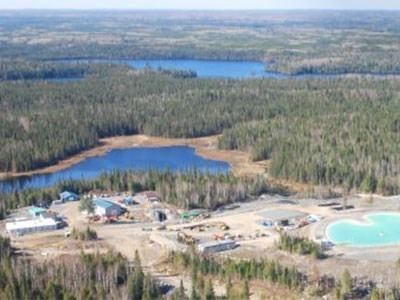In 2013, IAMGOLD held out a lot of promise for its Côté Gold project near Gogama, acquired a year earlier from Trelawney Mining. But then the price of gold dropped, and the project was put on the backburner.
“As with most mining companies, we just tried to survive,” said Steve Woolfenden, IAMGOLD’s director of environment, during an April 21 talk in Sudbury to kick off that city’s Modern Mining and Technology Week.
“We’ve managed through that downturn.”
In the background, IAMGOLD was still chipping away at the environmental assessment (EA) process, and today, the company has emerged with a renewed optimism about the project, although the plan has been amended from its earlier version.
The Côté Gold project is located almost halfway between Timmins and Sudbury, about five kilometres west of Highway 144.
In its previous iteration, the proposal called for a 15-year mine life, a mill rate of 60,000 tonnes per day, and a requirement of 1,200 employees — 500 for construction alone.
“At the time, we thought bigger was better,” Woolfenden said.
But the company is now considering a scaled-back footprint for the proposed operation.
The project has earned both its federal and provincial EA certificates, and in February IAMGOLD announced the completion of a positive preliminary economic assessment (PEA), indicating it would start work on a prefeasibility study.
According to the PEA, the proposed open-pit gold mine has an indicated resource of 8 million ounces and an inferred resource of another 1 million ounces.
The mine, which would have an initial capital cost of $1.031 billion, would have a production life of 21 years. The PEA outlines a mill rate of 29,000 tonnes per day, with an average annual gold production of 302,000 ounces.
Woolfenden said the company is still doing exploration in the area to see if it can expand the resource to add more life to the mine, which will ultimately benefit the community.
“When you have a big mine with a short mine life, it becomes really hard to work with the community because it's a lot of money flowing through for a short period of time,” he said.
He anticipates a prefeasibility study to be ready by late June or early July, and if it’s approved, IAMGOLD will move right into a feasibility study.
An innovative feature of the mine is IAMGOLD’s proposal to use a high-pressure grinding roll (HPGR), rather than the more commonly used ball or semi-autogenous grinding (SAG) mills.
A HPGR has two large cylinders that spin and crush the rock, as opposed to one rock spinning around a big tub, Woolfenden explained.
“Côté’s rock is some of the hardest rock you see on the planet, and it’s some of the most abrasive rock you see on the planet,” he said. “When you combine those two factors, SAG and ball are not super efficient, so we’re looking at using this other technology to grind the rock.”
Going that route is expected to be more efficient and will require a smaller mill. It will also be more energy-efficient, alleviating the need for IAMGOLD to clear a corridor to build a new 230-kilovolt powerline from Timmins down to the Côté site.
Instead, the company will use an existing corridor from a previous mine that leads from Shining Tree right into the mine site. It will come as welcome news to Mattagami First Nation, which had expressed concern about the corridor work infringing on their moose hunting territory.
Even though the EA work has been completed and approved, Woolfenden said the company also plans to submit an ‘environmental effects review,’ which will outline how the company can further improve its environmental footprint in an updated report this fall.
Among the improvements is the relocation of the tailings facility away from an existing creek. IAMGOLD acquired land from San Antonio Resources early last year, and the company is looking at that property for its tailings facility, Woolfenden said. Water quality monitoring is now underway.
The PEA for Côté Gold was defined using a gold price of $1,200 per ounce. If gold remains around that price, or improves, Woolfenden said Côté’s future will become that much brighter in what he called a “world-class camp.”
“That world-class camp is really due to you, as a community,” he said. “Sudbury, Timmins have lots of benefits, and it’s very attractive for a company like IAMGOLD to bring a mining project to this jurisdiction.”
The Côté Gold mine would be IAMGOLD’s first foray into Northern Ontario. It has operational mines in Val d’Or, Que., Suriname, Burkina Faso and Mali, in addition to exploration projects in Senegal and Brazil.




